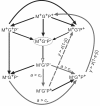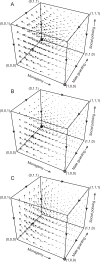Blackmailing: the keystone in the human mating system
- PMID: 22122975
- PMCID: PMC3247298
- DOI: 10.1186/1471-2148-11-345
Blackmailing: the keystone in the human mating system
Abstract
Background: The human mating system is characterized by bi-parental care and faithful monogamy is highly valued in most cultures. Marriage has evolved as a social institution and punishment for extra pair mating (EPM) or adultery is common. However, similar to other species with bi-parental care, both males and females frequently indulge in EPM in secrecy since it confers certain gender specific genetic benefits. Stability of faithful monogamy is therefore a conundrum. We model human mating system using game theory framework to study the effects of factors that can stabilize or destabilize faithful committed monogamy.
Results: Although mate guarding can partly protect the genetic interests, we show that it does not ensure monogamy. Social policing enabled by gossiping is another line of defense against adultery unique to humans. However, social policing has a small but positive cost to an individual and therefore is prone to free riding. We suggest that since exposure of adultery can invite severe punishment, the policing individuals can blackmail opportunistically whenever the circumstances permit. If the maximum probabilistic benefit of blackmailing is greater than the cost of policing, policing becomes a non-altruistic act and stabilizes in the society. We show that this dynamics leads to the coexistence of different strategies in oscillations, with obligate monogamy maintained at a high level. Deletion of blackmailing benefit from the model leads to the complete disappearance of obligate monogamy.
Conclusions: Obligate monogamy can be maintained in the population in spite of the advantages of EPM. Blackmailing, which makes policing a non-altruistic act, is crucial for the maintenance of faithful monogamy. Although biparental care, EPM, mate guarding and punishment are shared by many species, gossiping and blackmailing make the human mating system unique.
Figures




Similar articles
-
The benefit and the doubt: why monogamy?J Psychosom Obstet Gynaecol. 2003 Mar;24(1):55-61. doi: 10.3109/01674820309042802. J Psychosom Obstet Gynaecol. 2003. PMID: 12685340
-
Monogamy in marine fishes.Biol Rev Camb Philos Soc. 2004 May;79(2):351-75. doi: 10.1017/s1464793103006304. Biol Rev Camb Philos Soc. 2004. PMID: 15191228 Review.
-
Why do some animals mate with one partner rather than many? A review of causes and consequences of monogamy.Biol Rev Camb Philos Soc. 2018 Nov;93(4):1795-1812. doi: 10.1111/brv.12421. Epub 2018 Apr 23. Biol Rev Camb Philos Soc. 2018. PMID: 29687607 Review.
-
Male infanticide leads to social monogamy in primates.Proc Natl Acad Sci U S A. 2013 Aug 13;110(33):13328-32. doi: 10.1073/pnas.1307903110. Epub 2013 Jul 29. Proc Natl Acad Sci U S A. 2013. PMID: 23898180 Free PMC article.
-
Female mate preference to maximize paternal care. II. Female competition leads to monogamy.Am Nat. 1998 Apr;151(4):367-82. doi: 10.1086/286125. Am Nat. 1998. PMID: 18811327
Cited by
-
Decision makers use norms, not cost-benefit analysis, when choosing to conceal or reveal unfair rewards.PLoS One. 2013 Sep 16;8(9):e73223. doi: 10.1371/journal.pone.0073223. eCollection 2013. PLoS One. 2013. PMID: 24066040 Free PMC article.
References
-
- Clutton-Brock TH, Russell AF, Sharpe LL, Jordan NR. 'False feeding' and aggression in meerkat societies. Anim Behav. 2005;69:1273–1284. doi: 10.1016/j.anbehav.2004.10.006. - DOI
MeSH terms
LinkOut - more resources
Full Text Sources

